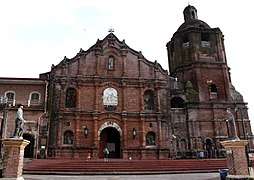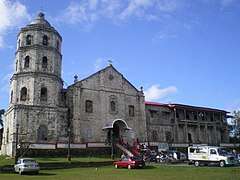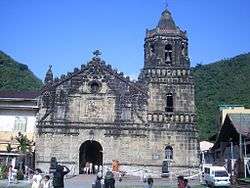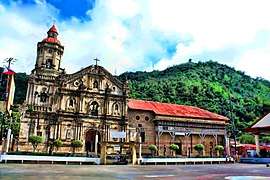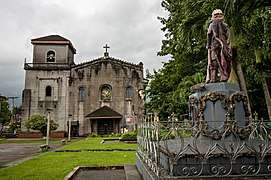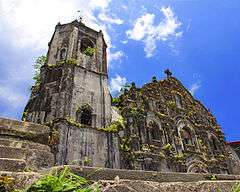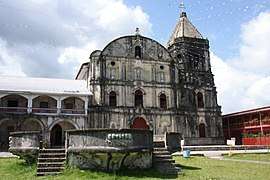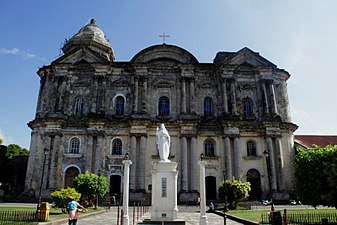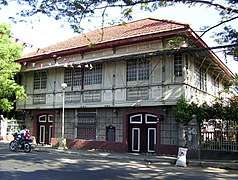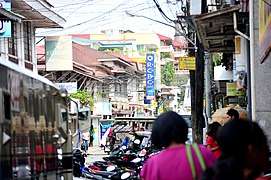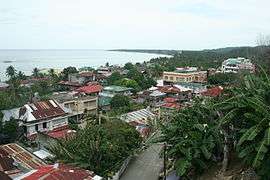Tagalog people
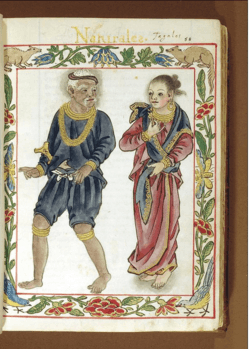 A Maginoo (noble class) couple, both wearing blue-coloured clothing articles (blue being the distinctive colour of their class). | |
| Total population | |
|---|---|
| c. 30 million (in Philippines)[1] | |
| Regions with significant populations | |
|
(Metro Manila, CALABARZON, Central Luzon, MIMAROPA) | |
| Languages | |
| Tagalog (Filipino), other Philippine languages, English, and minority Spanish | |
| Religion | |
|
Christianity: Catholic, Iglesia ni Cristo, Mormon and Protestant Islam, Buddhism, Anitism (Tagalog religion) | |
| Related ethnic groups | |
| Bicolanos, Kapampangans, Pangasinans, Ilocanos, Visayans, Malays, other Austronesians |
The Tagalog people (Baybayin: ᜋᜅ ᜆᜄᜎᜓᜄ᜔) are a major ethnolingustic group in the Philippines. They have a well developed society due to their cultural heartland, Manila, being the capital city of the Philippines. Most of them inhabit and form a majority in the Metro Manila and Calabarzon regions of southern Luzon, as well as a plurality in the provinces of Bulacan, Bataan, Zambales, Nueva Ecija and Aurora in Central Luzon and in the islands of Marinduque and Mindoro in MIMAROPA.
Etymology
The commonly accepted origin for the endonym "Tagalog" is the term tagá-ilog, which means "people from [along] the river". An alternative theory states that the name is derived from tagá-alog, which means "people from the ford" (the prefix tagá- meaning "coming from" or "native of").[2]
In 1821, American diplomat Edmund Roberts called the Tagalog "Tagalor" in his memoirs about his trips to the Philippines.[3]
History
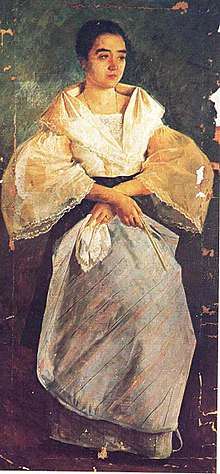

The Angono Petroglyphs in Rizal was most likely been made by Austronesian peoples, of which the most likely are the ancestors of the Tagalog people. There are 127 human and animal figures engraved on the rock wall, that were probably carved during the late Neolithic, or before 2000 BC. According to archaeologists, the human figures on the wall were infants, and that the ancient Tagalogs most likely believed that drawing the figures of their sick children on the 'sacred wall' would clear their children from diseases.
The earliest written record of Tagalog is a late 9th-century document known as the Laguna Copperplate Inscription which is about a remission of debt on behalf of the ruler of Tondo.[4] Inscribed on it is year 822 of the Saka Era, the month of Waisaka, and the fourth day of the waning moon, which corresponds to Monday, April 21, 900 CE in the Proleptic Gregorian calendar.[5] The writing system used is the Kawi script, while the language is a variety of Old Malay, and contains numerous loanwords from Sanskrit and a few non-Malay vocabulary elements whose origin may be Old Javanese. Some contend it is between Old Tagalog and Old Javanese.[6] The document states that it releases its bearers, the children of Namwaran, from a debt in gold amounting to 1 kati and 8 suwarnas (865 grams).[7][5] Around the creation of the copperplate, a complex society with sarcophagi burial practices developed in the Bondok peninsula in Quezon province. Also, the polities in Namayan, Manila, and Tondo, all in the Pasig river tributary, were established. Various Tagalog societies were also established in Calatagan, Tayabas, shores of Lake Laguna, Marinduque, and Malolos. The enhancements of these Tagalog societies until the middle of the 16th century made it possible for other Tagalog societies to spread and develop various cultural practices such as those concerning the dambana. During the reign of Sultan Bolkiah in 1485 to 1521, the Sultanate of Brunei decided to break Tondo's monopoly in the China trade by attacking Tondo and establishing Selurung as a Bruneian satellite-state.[8][9]
Tomé Pires noted that the Luções or people from Luzon were "mostly heathen" and were not much esteemed in Malacca at the time he was there, although he also noted that they were strong, industrious, given to useful pursuits. Pires' exploration led him to discover that in their own country, the Luções had foodstuffs, wax, honey, inferior grade gold, had no king, and were governed instead by a group of elders. They traded with tribes from Borneo and Indonesia and Filipino historians note that the language of the Luções was one of the 80 different languages spoken in Malacca.[10] When Magellan's ship arrived in the Philippines, Pigafetta noted that there were Luções there collecting sandalwood.[11] Contact with the rest of Southeast Asia led to the creation of Baybayin script that was later used in the book Doctrina Cristiana, which is written by the 16th century Spanish colonizers.[12]
On May 19, 1571, Miguel López de Legazpi gave the title "city" to the colony of Manila.[13] The title was certified on June 19, 1572.[13] Under Spain, Manila became the colonial entrepot in the Far East. The Philippines was a Spanish colony administered under the Viceroyalty of New Spain and the Governor-General of the Philippines who ruled from Manila was sub-ordinate to the Viceroy in Mexico City.[14] Throughout the 333 years of Spanish rule, various grammars and dictionaries were written by Spanish clergymen, including Vocabulario de la Lengua Tagala by Pedro de San Buenaventura (Pila, Laguna, 1613), Pablo Clain's Vocabulario de la lengua tagala (beginning of the 18th century), Vocabulario de la lengua tagala (1835), and Arte de la lengua tagala y manual tagalog para la administración de los Santos Sacramentos (1850) in addition to early studies of the language.[15] The first substantial dictionary of Tagalog language was written by the Czech Jesuit missionary Pablo Clain in the beginning of the 18th century.[16] Further compilation of his substantial work was prepared by P. Juan de Noceda and P. Pedro de Sanlucar and published as Vocabulario de la Lengua Tagala in Manila in 1754 and then repeatedly[17] re-edited, with the last edition being in 2013 in Manila.[18] The indigenous poet Francisco Baltazar (1788–1862) is regarded as the foremost Tagalog writer, his most notable work being the early 19th-century epic Florante at Laura.[19]
The first Asian-origin people known to arrive in North America after the beginning of European colonization were a group of Filipinos known as "Luzonians" or Luzon Indians who were part of the crew and landing party of the Spanish galleon Nuestra Señora de la Buena Esperanza. The ship set sail from Macau and landed in Morro Bay in what is now the California coast on October 17 of 1587, as part of the Galleon Trade between the Spanish East Indies (the colonial name for what would become the Philippines) and New Spain (Spain's colonies in North America).[20] More Filipino sailors arrived along the California coast when both places were part of the Spanish Empire.[21] By 1763, "Manila men" or "Tagalas" had established a settlement called St. Malo on the outskirts of New Orleans, Louisiana.[22]
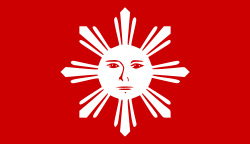
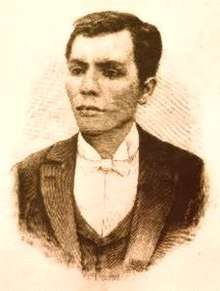
The Tagalog played an active role during the 1896 Philippine Revolution and many of its leaders were either from Manila or surrounding provinces.[23] The Katipunan once intended to name the Philippines as "Katagalugan" or the Tagalog Republic,[24] and extended the meaning of these terms to all natives in the Philippine islands.[25][26] Miguel de Unamuno described revolutionary leader José Rizal (1861–1896) as the "Tagalog Hamlet" and said of him “a soul that dreads the revolution although deep down desires it. He pivots between fear and hope, between faith and despair.”[27] In 1902, Macario Sakay formed his own Republika ng Katagalugan in the mountains of Morong (today, the province of Rizal), and held the presidency with Francisco Carreón as vice president.[28]
Tagalog was declared the official language by the first constitution in the Philippines, the Constitution of Biak-na-Bato in 1897.[29] In 1935, the Philippine constitution designated English and Spanish as official languages, but mandated the development and adoption of a common national language based on one of the existing native languages.[30] After study and deliberation, the National Language Institute, a committee composed of seven members who represented various regions in the Philippines, chose Tagalog as the basis for the evolution and adoption of the national language of the Philippines.[31][32] President Manuel L. Quezon then, on December 30, 1937, proclaimed the selection of the Tagalog language to be used as the basis for the evolution and adoption of the national language of the Philippines.[31] In 1939, President Quezon renamed the proposed Tagalog-based national language as wikang pambansâ (national language).[32] In 1959, the language was further renamed as "Pilipino".[32] The 1973 constitution designated the Tagalog-based "Pilipino", along with English, as an official language and mandated the development and formal adoption of a common national language to be known as Filipino.[33] The 1987 constitution designated Filipino as the national language mandating that as it evolves, it shall be further developed and enriched on the basis of existing Philippine and other languages.[34]
Society
The Tagalog number around 30 million, making them the largest indigenous Filipino ethno-linguistic group in the country. The second largest is the Sebwano with around 20 million.[35] Tagalog settlements are generally lowland, and are commonly sited on the banks near the delta and "wawà" or mouth of a river.[36] The traditional clothing of the Tagalog, the Barong Tagalog, is the folk costume of the Philippines, while the national language of the Philippines, which is Filipino, is derived mainly from the Tagalog language.[37]
The Tagalog mostly practice Christianity (majority Catholicism and minority Protestantism) with a minority practicing Islam, Buddhism, Anitism (indigenous Tagalog religion), and other religions as well as no religion.[36]
Cuisine
Bulacan is popular for chicharon (crunchy pork rind chips) and steamed rice and tuber cakes like puto. It is a center for panghimagas or desserts, like brown rice cake or kutsinta, sapin-sapin, suman, cassava cake, halaya ube and the king of sweets, in San Miguel, Bulacan, the famous carabao milk candy pastillas de leche, with its pabalat wrapper.[38] Antipolo, the capital of Rizal province, straddled mid-level in the mountainous regions of the Philippine Sierra Madre, is a city known for its suman and cashew products. Cainta, also in Rizal, is also known for its suman rice cakes and puddings. These are usually topped with latik, a mixture of coconut milk and brown sugar, reduced to a dry crumbly texture. A more modern, and time saving alternative to latik are coconut flakes toasted in a frying pan.
Laguna is known for buko pie (coconut pie) and panutsa (peanut brittle). Batangas is home to Taal Lake, a body of water that surrounds Taal Volcano. The lake is home to 75 species of freshwater fish. Among these, the maliputo and tawilis are two not commonly found elsewhere. These fish are delicious native delicacies. Batangas is also known for its special coffee, the strong-tasting kapeng barako. Bistek Tagalog is a dish of strips of sirloin beef slowly cooked in soy sauce, calamansi juice, vinegar and onions. Records have also shown that kare-kare is the Tagalog dish that the Spanish first tasted when the landed in pre-colonial Tondo.[39]
Clothing

.jpg)
.jpg)
Majority of Tagalogs before colonization wore garments woven by the locals, much of which showed sophisticated designs and techniques. The Boxer Codex also illuminates the intricate and high standard in Tagalog clothing, especially among the high society. High society members, which include the datu and the katolonan, also wore accessories made of prized materials. Slaves on the other hand wore simple clothing, seldom loincloths.
During later centuries, Tagalog nobles would wear the barong tagalog for men and the baro't saya for women. When the Philippines became independent, the barong Tagalog became popularised as the national costume of the country, as the wearers were the majority in the new capital, Manila.
Craftsmanship
The Tagalog people were also craftsmen. The katolanan, specifically, of each barangay is tasked as the holder of arts and culture, and usually trains craftfolks if ever no craftfolks are living in the barangay. If the barangay has a craftsfolk, the present crafts-folks would teach their crafts to gifted students. Notable crafts made by ancient Tagalogs are boats, fans, agricultural materials, livestock instruments, spears, arrows, shields, accessories, jewelries, clothing, houses, paddles, fish gears, mortar and pestles, food utensils, musical instruments, bamboo and metal wears for inscribing messages, clay wears, toys, and many others.
Belief on the soul and pangangaluluwa
The Tagalog people traditionally believe in the two forms of the soul. The first is known as the kakambal (literally means twin), which is the soul of the living. Every time a person sleeps, the kakambal may travel to many mundane and supernatural places which sometimes leads to nightmares if a terrible event is encountered while the kakambal is travelling. When a person dies, the kakambal is ultimately transformed into the second form of the Tagalog soul, which is the kaluluwa (literally means spirit). In traditional Tagalog religion, the kaluluwa then travels to either Kasanaan (if the person was evil when he was living) or Maca (if the person was good when he was living) through sacred tomb-equipped psychopomp creatures known as buwaya[40][40] or through divine intervention. Both domains are ruled by Bathala, though Kasanaan is also ruled by the deity of souls.[41]
In addition to the belief in the kaluluwa, a tradition called pangangaluluwa sprang. The pangangaluluwa is a traditional Tagalog way of aiding ancestor spirits to arrive well in Maca (place where good spirits go) or to make ancestor spirits that may have been sent to Kasanaan/Kasamaan (place where bad spirits go) be given a chance to be cleansed and go to Maca. The tradition includes the peoples (which represent the kaluluwa of people who have passed on), and their oral tradition conducted through a recitation or song. The people also ask for alms from townsfolk, where the alms are offered to the kaluluwa afterwards. This tradition, now absorbed even in the Christian beliefs of Tagalogs, is modernly-held between October 27 to November 1, although it may be held on any day of the year if need be during the old days. The traditional pangangaluluwa song's composition is:[42][43] Kaluluwa’y dumaratal (The second souls are arriving); Sa tapat ng durungawan (In front of the window); Kampanilya’y tinatantang (The bells are ringing); Ginigising ang may buhay (Waking up those who still have life); Kung kami po’y lilimusan (If we are to be asked to give alms); Dali-daliin po lamang (Make it faster); Baka kami’y mapagsarhan (We may be shut); Ng Pinto ng Kalangitan (From the doors of heaven).[42] The Kalangitan in the lyrics would have been Maca during the classical era.[42][43]
Additional lyrics are present in some localities. An example is the additional 4 lines from Nueva Ecija:[42][43] Bukas po ng umaga (Tomorrow morning); Tayong lahat ay magsisimba (We will go to the shrine); Doon natin makikita (There, we will see); Ang misa ng kaluluwa! (The mass of the second souls!)[42]
Belief on dreams
The Tagalog people traditionally believe that when a person sleeps, he may or may not dream the omens of Bathala. The omens are either hazy illusions within a dream, the appearance of an omen creature such as tigmamanukan, or sightings from the future. The dream omens do not leave traces on what a person must do to prevent or let the dream come true as it is up to the person to make the proper actions to prevent or make the dream come true. The omen dreams are only warnings and possibilities 'drafted by Bathala'.
Additionally, a person may sometimes encounter nightmares in dreams. There are two reasons why nightmares occur, the first is when the kakambal soul encounters a terrifying event while travelling from the body, or when a bangungot creature sits on top of the sleeping person in a bid of vengeance due to the cutting of her tree home. Majority of the nightmares are said to be due to the kakambal soul encountering terrifying events while travelling.[41][44]
Belief on the cosmos
Ancient Tagalogs initially believed that the first deity of the sun and moon was Bathala, as he is a primordial deity and the deity of everything. Later on, the title of deity of the moon was passed on to his favorite daughter, Mayari, while the title of deity of the sun was passed on to his grandson and honorary son, Apolaki. One of his daughters, Tala is the deity of the stars and is the primary deity of the constellations, while Hanan was the deity of mornings and the new age. The Tagalog cosmic beliefs is not exempted from the moon-swallowing serpent myths prevalent throughout the different ethnic peoples of the Philippines. But unlike the moon-swallowing serpent stories of other ethnic peoples, which usually portrays the serpent as a god, the Tagalog people believe that the serpent which causes eclipses is a monster dragon, called Laho, instead. The dragon, despite being strong, can easily be defeated by Mayari, the reason why the moon's darkness during eclipses diminishes within minutes.[45]
Burial practices
The Tagalog people had numerous burial practices prior to Spanish colonization and Catholic introduction. In rural areas of Cavite, trees are used as burial places. The dying person chooses the tree beforehand, thus when he or she becomes terminally ill or is evidently going to die because old age, a hut is built close to the said tree. The deceased's corpse is then entombed vertically inside the hollowed-out tree trunk. Before colonization, a statue known as likha is also entombed with the dead inside the tree trunk. In Mulanay, Quezon and nearby areas, the dead are entombed inside limestone sarcophagi along with a likha statue. However, the practice vanished in the 16th century due to Spanish colonization. In Calatagan, Batangas and nearby areas, the dead are buried under the earth along with likha statues. The statues, measuring 6-12 inches, are personified depictions of anitos. Likha statues are not limited to burial practices as they are also used in homes, prayers, agriculture, medicine, travel, and other means; when these statues are used as such, they are known as larauan, which literally means image.[46]
Religion
The Tagalog people initially had their own unique religion, modernly known as Tagalismo as the original name of the religion is unknown and was not documented by the Spanish. Spanish accounts also call the Tagalog religion as Anitismo (or Anitism in English) and Anitheria, the former is accepted by Tagalog scholars and present-day Anitist adherents while the later is seen as a derogatory term. The practices of Tagalismo were usually done within a dambana. When the Spanish arrived, Roman Catholicism was forcefully inputted by the colonizers who tried to destroy all other religions they deemed as 'lesser' than European religions. At the present, the majority of Tagalogs belong to the Roman Catholic Church, while a relatively smaller amount belong to various Protestant sects or nationalized Christian Churches. A small number of Tagalogs, however, have managed to revert to Tagalismo/Anitismo. Some Tagalogs also adhere to Islam, although their number is extremely small and fragmented.
Anitism/Tagalismo
The pre-colonial religion of the Tagalog people was a Syncretic form of indigenous Tagalog belief systemsn, Hinduism, and Buddhism. The religion revolved around the community through the katalonan and the dambana, known also as lambana in the Old Tagalog language.[47][48][49] The ancient Batangueños were influenced by India as shown in the origin of most languages from Sanskrit and certain ancient potteries. A Buddhist image was reproduced in mould on a clay medallion in bas-relief from the municipality of Calatagan. According to experts, the image in the pot strongly resembles the iconographic portrayal of Buddha in Siam, India, and Nepal. The pot shows Buddha Amithaba in the tribhanga[47] pose inside an oval nimbus. Scholars also noted that there is a strong Mahayanic orientation in the image, since the Boddhisattva Avalokitesvara was also depicted.[48] The Lokesvara bronze statue of Lokesvara was found in Isla Puting Bato in Tondo, Manila.[50]
The shamanistic mix of polytheism and animism, collectively called Tagalismo (Tagalog religion) or Anitism (Anito religion). Prior to Spanish arrival and Catholic seeding, the ancient Tagalog people used to cover the following: present-day Calabarzon region except the Polillo Islands, northern Quezon, Alabat island, the Bondoc Peninsula, and easternmost Quezon; Marinduque; Bulacan except for its eastern part; and southwest Nueva Ecija, as much of Nueva Ecija used to be a vast rainforest where numerous nomadic ethnic groups stayed and left. When the polities of Tondo and Maynila fell due to the Spanish, the Tagalog-majority areas grew through Tagalog migrations in portions of Central Luzon and north Mimaropa as a Tagalog migration policy was implemented by Spain. This was continued by the Americans when they defeated Spain in a war. There have been attempts to restore the Tagalog indigenous religion as the religion for the Tagalog people.
The territories where the ancient Tagalog pantheon was worshiped were the areas that were under Tagalog-majority influence prior to the biggest expansion of Tondo. During that time, Hindu influences in customs and traditions were present due to trade with other Asian independent or vassal states. The first part as shown below are the residents of Kaluwalhatian (the abode of the gods, roughly corresponding to the Christian idea of Heaven). The term, anito, has three meanings. The first is deity (gods and goddesses) including Bathala and the lower deities living and not living in Kaluwalhatian. The second is non-ancestral spirits, the beings sent by Bathala along with the deities to aid mankind in everyday life. These non-ancestral spirit anitos can be formless or possess forms of various beings. The last is ancestral spirits, the souls of human beings who have passed on. These ancestral spirit anitos can also be summoned by Bathala to aid their relatives and descendants in special cases, usually through dreams or flickers of light. Aside the from the anitos, there are also beings lower than them. These beings are diverse in forms and are considered as monsters (example is the aswang) and/or guardians (example is the tikbalang) that roam the world along with mankind. These beings usually reside within the confines of nature, but when disturbed, can inflicts severe damages to man and even cause death. Tagalogs who had spiritual prowess to contact the deities and anitos were known as katolanon. The katolanon, being the spiritual leader and personified contact to the deities, also assumed the role of the datu if the datu has not yet returned from his travels. He also acts as the datu during transition periods, where the official datu (leader) has yet to be chosen. Like the datu, the katolanon may be male or female. Katolanon may choose to have a wife or husband as partner with his or her spiritual activities, regardless of gender. The katolanon, male or female, usually has a female gender expression, according to Spanish accounts. The reason for this is because a female expression is the embodiment of natural spiritual balance, and is pleasing to the Tagalog deities. In times when certain barangays choose to establish a unification pact with other barangays, the datus of each barangay will vote among themselves who will be considered as the lakan (also known as punong datu), which is regarded as the head of all the datus within the pact. To establish the pact, a sandugo or blood compact is made. The katolanan of the datu, that was made into lakan, is also uplifted into the title of punong katolanan (head katolanan). The most known unification of barangays in pre-colonial Tagalog history are the unification of Tondo barangays (those at the northern edge of the Pasig river), the unification of Manila barangays (those at the southern edge of the Pasig river), the unification of Namayan barangays (those upstream of the Pasig), the unification of Kumintang barangays (those west of Batangas), and the unification of Pangil barangays (those east and south of Laguna de Bay). The first two barangay unification were most likely triggered by conflicts between the two Tagalog sides of the river, while the Namayan unification was most likely triggered by economic means as all trade between the barangays around Laguna de Bay and barangays at Manila Bay need to pass through Namayan via the Pasig river. The unification of Kumintang barangays was probably due to economic ties as traders from East Asia flocked the area, while the unification of Pangil barangays was said to be due to a certain Gat Pangilwhil unified the barangays under his lakanship. Present-day Tondo is the southern section of Manila's Tondo district, while present-day Maynila is Manila's Intramuros district. Present-day Namayan is Manila's Santa Ana district. Present-day Pangil is the eastern and southern shores of Laguna and a small portion of northern Quezon province. Present-day Kumintang is the areas of western Batangas. The Kumintang barangays are sometimes referred as the 'homeland' of the Tagalog people, however, it is contested by the Tagalogs of Manila.[51]
| Name | God(dess) of... | Generation |
|---|---|---|
| Bathala | Sometimes referred as Abba, he is the supreme god of being; creator of man and earth and addressed sometimes as Bathalang Maykapal. He dwells in Kaluwalhatian together with the lesser gods and goddesses. Aside from the lesser gods and goddesses, he sent his anitos (ancestral spirits of mankind) in order to assist the daily lives of every human. He provided everything mankind needed, to a point where he spoiled them too much, hence, the Tagalog philosophy of bahala na (what comes will come, let it be). However, despite his intense kindness and love for mankind, he has also the capability to punish mankind through famine, diseases, and lightning. When he went into a deep slumber, he let Apolaki (his grandson who would later be known as his son) and Mayari (his daughter) rule in his place. This action led to the pre-colonial Tagalog notion that the younger generations also have the capability to become leaders. Many datus (community leaders) during the pre-colonial era were young men and women. In some accounts during the Spanish occupation, Bathala was not in deep slumber, but 'died' instead. This source is believed to have been crafted by Spanish friars so that Tagalogs at the time would stop believing in Bathala and would instead embrace the Christian God who the friars branded as 'undying', and therefore 'more powerful'. When most of the natives were converted to Christianity during the Spanish Era, Bathala was referred interchangeably by many as the Christian God, as the natives would not let his name be forgotten despite threats from the Spanish colonialists and friars. Researchers have suggested that Bathala's name is Hindu in origin as it comes from the Sanskrit word, bhattara, meaning noble lord. In Tagalog animism, the tigmamanukan omens (which can be a bird, lizard, or snake) were Bathala's emblems. In some accounts, Bathala chose the tigmamanukan creatures, especially the bird, as his messengers as they look like the bird form of his friend, Amihan, a primordial deity. A tigmamanukan omen bird was used by Bathala to split the bamboo that would let out the first man, Malakas, and woman, Maganda. The tigmamanukan omens were also used by Bathala to warn mankind if they should continue or discontinue their journey. If a traveler sees a tigmamanukan omen, and it passes from right to left, then it symbolizes as labay (Bathala's approval to proceed with the journey). If the tigmamanukan omen passes from left to right, the traveller should not proceed, or else he or she will never return. According to Tagalog elders, the tigmamanukan omen birds had blue strikes on their feathers and live in the mythical Mount Batala (a mountain dedicated to Bathala). According to research, the most probable bird species qualified as a tigmamanukan omen bird, as described by elders, is the fairy bluebird from the genus Irena.[52] | First[A] |
| Amanikable | Originally this god was worshipped as the god of Hunters who provided good game to his worshippers. He gave titles to people who proved their prowess in hunting. In more modern stories he has become associated as the husky, ill-tempered god of the sea, replacing Aman Sinaya among of the first generation gods (aside from Bathala), he was never married after his love was spurned by a beautiful mortal maiden, Maganda, the first woman who was the partner of Malakas, the first man. Both came out from a bamboo that was pecked by Bathala's sacred bird, the tigmamanukan bird according to traditional Tagalog tales (but sometimes the sarimanok according to Tagalogs who migrated to the southern islands where the sarimanok is more known). In frustration, he swore vengeance against the humans by sending turbulent waves and horrible tempests in order to wreck boats and to drown men. Despite this, he is also wise and will help men if they earn his praise. This notion is in line with the dogma that Tagalog deities who are welcome in Kaluwalhatian are all kind. Amanikable has a cordial relationship with Haik, the sea god who brings peace to the sea, which is the opposite of Amanikable's sea prowess. In Tagalog animism, the hunter was Amanikable's emblem.[53] | First[B] |
| Idiyanale | Also known as Idianale or Idianali. She is the goddess of labor and good deeds. In some accounts, she is also a female deity of animal husbandry, and a male deity of agriculture. Natives used to call for her guidance in order to make their works successful. If a person does not call her name, the work being conducted may not be finished in time, not finished properly, or not finished at all. She is friends with the mischievous Bibit and medicine deity Lingga. She married Dimangan and had two offspring, namely, Dumakulem and Anitun Tabu. Her nature of needing to be considered was passed down to Anitun Tabu, while her nature o hard work was passed down to Dumakulem. In Tagalog animism, the water buffalo was Idiyanale's emblem.[54] | First[C][D] |
| Dimangan | Also known as Dumangan. He is the sky god of good harvest. People offer him words of praise and respect to have a bountiful harvest and for the crops to yield better quality grains. In old tradition, singing songs for Dimangan is conducted to appease the god while harvesting the bounties he blessed on men. He has the capability to enhance the harvests of men with a wave of his hand. Because of this, he is praised together with Lakapati, who taught agriculture to mankind. He was married to Idiyanale and had two offspring, namely Dumakulem and Anitun Tabu. His nature of needing appeasement was passed down to Anitun Tabu, while his nature of giving aid to people was passed down to Dumakulem. In Sambal mythology, Dimangan had three brothers with equal strength as him, namely, Kalasakas, who hastened the ripening of rice stalks, Kalasokus, who was responsible for turning the grains from green to yellow, and Damulag, who protected the flowers of the rice plants from destructive hurricanes. In Tagalog polytheism, a basket of bounties was Dimangan's emblem.[53] | First |
| Lakapati | The goddess of fertility and the most understanding and kind of all the deities. S/he was a hermaphrodite, having both female and male genitalia, symbolizing the balance of everything. Her bodily expression is notably feminine. Also known as Ikapati, s/he was the giver of food and prosperity. Her/His best gift to mankind was agriculture (cultivated fields), a reason why s/he is praised along with Dimangan, god of good harvest. Through her/his teachings, s/he was respected and loved by the people. S/he was known to be the kindest deity to the Tagalogs. Later, s/he married Mapulon, who courted her/him tirelessly. Her/His marriage with Mapulon was symbolic for the ancient Tagalogs as it referred to marriage as a mutual bond between two parties regardless of gender, which was common and an acceptable practice at the time. They had a daughter, named Anagolay who aided mankind when they have lost something or someone. During early Spanish rule, Lakapati was depicted as the Holy Spirit, as the people continued to revere her despite Spanish threats. In Tagalog animism, the small unhusked rice grain was Lakapati's emblem.[54] | First[E] |
| Mapulon | The god of seasons. He also sometimes associated as a deity of good health and medicine. Mapulon is known as the second kindest deity to the Tagalogs, after Lakapati. He gave good seasons and health to mankind, and whenever a person is ill, medicinal herbs grow due to his prowess of commanding the seasons, providing men with something to heal themselves with. He fell in love with Lakapati due to Lakapati's kindness and understanding towards the people despite the mistakes made by mankind. At first, Lakapati was not interested with Mapulon, but eventually, Lakapati fell in love with him due to his tireless actions of love and they got married. Their story exemplifies why pre-colonial Tagalog men would court the person they love tirelessly for years, sometimes up to a decade, awaiting their loved one to fall in love with them as well through sheer determination. Mapulon and Lakapati had a daughter named Anagolay. Mapulon's emblem is undetermined.[53] | First |
| Mayari | The goddess of the moon, war, revolution, and right to equal rule. She is also associated with healing and lunar emotions. She is one of the three daughters of Bathala by a mortal woman. She was the most charming of all the goddesses, until one of her eyes were taken off by Apolaki in a battle. She has no hatred towards Apolaki, however, as the god did everything he could to make amends, though Mayari's eye was never healed. She had two sisters, Tala and Hanan, who she has very good ties with. In some stories, she became the ruler of the earth every night when her father Bathala was in a deep slumber, in contrast, Apolaki rules every day when Bathala was in deep slumber. In Tagalog polytheism, the moon was Mayari's emblem.[55] | Second[F][G] |
| Tala | The goddess of the stars; sister of Mayari and Hanan and one of the three daughters of Bathala by a mortal woman. People looked up to her for direction during nighttime. Her light at night is said to guide men to safety, along with the extended aura of Anagolay. She is known to have supported the creation of the Tagalog constellations whose names have been forgotten due to the influx of Western names and depictions on constellations. Tala used light spheres or orbs to ferry men to safety at night, however, when the Spaniards came, they demonized the light orbs and called it santelmos. The natives eventually regarded the santelmos as deadly beings that kill humans or get humans to lose their way. In Tagalog animism, the stars were Tala's emblem.[55] | Second[H] |
| Hanan | The goddess of morning; sister of Mayari and Tala and one of the three daughters of Bathala by a mortal woman. The first prayer of the day is given to Bathala, Apolaki, and her as a sign of a new day. She is specially important during the entrance of a new age or a new phase in a person's life. People offer her bountiful harvests and prayers during the birth of a child, the womanhood or manhood or a child, and the death of a person, entrance of the planting season, beginning of the harvest season, and start of a new annual cycle. These prayers are only conducted at the break of dawn. In Tagalog animism, the rooster and the dawning sun was Hanan's emblem.[55] | Second |
| Dumakulem | The strong, agile guardian of mountains and the son of Idiyanale and Dimangan. He also known as a sky god. He aids people who get lost in the mountains. He hates people who destroys the mountain's forests and wildlife, however, he never intentionally strays people in mountains as he is a kind god, but he does not help those who destroy the mountains and excessively hunt wildlife. It is said that he creates mountains to shield the people from the terrible storms caused by his sister, Anitun Tabu. Because of this, sometimes earthquakes occur, signaling the creation of mountains. He is always in good terms with his sister as both love the good side of men. He later married Anagolay. In Tagalog polytheism, the mountain was Dumakulem's emblem.[53] | Second |
| Anitun Tabu | The fickle-minded goddess of wind and rain. Every time it rains (ambon) and suddenly stops, it is said that the happy Anitun Tabu is nearby. If a storm is present, the angry Anitun Tabu is nearby. Due to the association of the ambon as a presence of the happy Anitun Tabu, the event eventually became a good time for marriages, until eventually, the better time for marriage was changed to sunny showers. This belief on marriage every sunny showers have been diverted in the Spanish era as a marriage between supernatural beings, and thus, ceased to be practiced by the common Tagalog. In later stories, Anitun Tabu was also known to be a mediator between warring supernatural beings, as she was associated with sunny showers, a sacred peace pact for supernatural beings. She was the daughter of Idiyanale and Dimangan and the sister of Dumakulem. To the neighboring pre-colonial Sambal people in west Luzon, Anitun Tabu (or Aniton Tauo to them) is male, conflicting with the beliefs of pre-colonial Tagalogs. According to Sambal mythology, Aniton Tauo was the most revered deity for the Sambals, however, he eventually became full of himself, leading to Malayari (male Zambal counterpart of Mayari) to punish and oast him from supremacy. Afterwards, he became of the deities to assist Malayari in his tasks. The pinipig (punded young rice grains) is offered to the Tagalog Anitun Tabu. The ritual offering to her is called mamiarag. In Tagalog animism, the rain was Anitun Tabu's emblem.[53] | Second |
| Anagolay | The goddess of lost things and the only offspring of Lakapati and Mapulon. Pre-Hispanized Tagalogs sought Anagolay's guidance whenever something or someone is lost. It is said that Anagolay's aura is present in the very fabric of everything, the very reason why she can find things and persons that are lost. However, she had both traits of her parents, goodness and a wide view in equality. Due to this, she never uses her power to take advantage of anyone. She was secretly in love with Dumakulem prior to their marriage. Anitun Tabu, sister of Dumakulem, offered her aid in pursuing Dumakulem as the rain goddess approved of Anagolay. However, Anagolay humbly rejected the offer as she does not honor forced love. Later on, Dumakulem fell in love with Anagolay's care for mankind and courted her for years until they got married. In Tagalog animism, a hole of light was Anagolay's emblem.[53] | Second |
| Apolaki | The god of sun, wisdom and strategy and the chief patron of warriors. Spanish accounts say he was ill-tempered, however, the Spanish used the image of the Greek god, Ares. In actual pre-colonial mythologies, Apolaki was a peaceful god who would fight for what he thinks was right and if he was wrong in the end, he would do his best to fix his wrong. This trait was exhibited during his battle with Mayari, where he apologized, after he put out one of Mayari's eyes, and agreed to Mayari's proposal for equal rights in ruling the earth. He was the son of Anagolay and Dumakulem. The neighboring pre-colonial Kapampangan people in central Luzon regarded Apolaki not a god of the sun as they already had one, but a goddess of the moon, conflicting with pre-colonial Tagalog beliefs. During the Spanish occupation, reports surfaced where Apolaki came down from Kaluwalhatian and scolded some Tagalog folks for 'welcoming men with white teeth'. The report was passed on by the townsfolk to the parish priest, thus documenting the said event. During pre-colonial Tagalog times, having black-pigmented teeth was the aesthetics, while having white teeth was seen as disgusting and unbearable. In Tagalog polytheism, the sun was Apolaki's emblem.[55] | Third (or Second)[I] |
| Diyan Masalanta | The goddess of love, conception and childbirth and the protector of lovers. She was in good relations with Ikapati, who presided over the fertility of mankind, the second stage to be determined after love and before conception. Sacrifices were offered to her so that conception is assured. She was the daughter of Anagolay and Dumakulem and youngest of all the deities. Spanish accounts imaged her like the Greek Aphrodite, but in actual pre-colonial mythologies, she was of more motherly nature and had a high standard in family values. She is wise and has waged battles against evil spirits to protect the family from breaking apart. Her mortal enemy is Manisilat, the breaker of families. She viewed the family as a web of interlaced families and communities, which is exhibited in the Tagalog tradition of extended families. In Tagalog animism, the actual human heart and the child were Diyan Masalanta's emblems. | Third |
Other definitions
- A^ In some sources, Bathala is the father of Apolaki, aside from Mayari and Tala hence excluding Hanan.[56]
- B^ In some sources, Amanikable is referred as a sea deity of the Manobo tribe.[57]
- C^ In some sources, Idiyanale is identified as the goddess of agriculture.[57]
- D^ In some sources, aside from being a goddess of agriculture, Idiyanale is also identified as the goddess of animal husbandry.
- E^ In some sources, Lakapati is identified as a hermaphrodite.
- F^ In some creation myth, Mayari is the sister of Apolaki.[58]
- G^ In some sources, Mayari is identified as a one-eyed goddess.[56]
- H^ In some creation myth, Tala is the sister of Mayari and Apolaki and the daughter of Bathala.[56]
- I^ In some creation myth, Apolaki is the brother of Mayari and the son of Bathala.[58]
The list includes the god/goddess-like, residents of Kasamaan (Ancient Tagalog counterpart of Hell), which is known as a 'village of grief and afflication'. They were the evil entities all opposed to Bathala and the rest of his deities. Kasamaan, also known as Kasanaan, is also the place where the spirits of evil humans are sent. In contrast, the spirits of good humans are sent to Maca. But whether a person died evil or good, he or she is still given the pabaon ritual, where the dead is given gifts that he or she may use in his or her journey to Kasamaan or Maca.[59]
| Name | Definition |
|---|---|
| Sitan | The guardian of Kasamaan and the keeper of all souls therein. He was depicted by the Spanish as the counterpart of Christianity's Satan. His real name has been lost in time. It is said that he came forth from nothing due to the evils of men, a story that symbolized the need of men to stay away from vices to not wake up the essence of Sitan. However, Sitan is not purely evil as he had aided mankind before, away from total annihilation, as he knows that a world without mankind is a world without his existence, and therefore, the destruction of Kasamaan, one of the dwellings of Tagalog anitos (ancestral spirits). He had four agents whose task was to lead man to sin and destruction, but also to aid those who are worthy of Sitan's help. According to another research, Sitan's name may have been derived from Saitan or Shaitan, the ruler of the Islamic underworld. This data concluded that during the Islamic era of the Tagalog domains, the original name of Sitan was replaced by the Islamic name already, making it impossible to determine the true indigenous name of Sitan. Sitan's emblem was a veil of darkness.[53] |
| Manggagaway | She was the first agent of Sitan and was primarily blamed as the cause of diseases. Sometimes, she would change herself into a human form, appearing as a false healer. If she wished to kill someone, she employed a sacred stick, veiled with the prowess of diseases. She can also prolong one's death for weeks or months by binding a snake, with a personally-concocted potion inside it, around the dying person's waist. She can be sent back to Kasamaan through the guidance of Bathala and the other gods of Kaluwalhatian or through the order of Sitan. Manggagaway's emblem was her sacred stick.[60] |
| Manisilat | Also known as Mansisilat. The second agent of Sitan, she was tasked to destroy and break every happy and united family that she could find. She does this by transforming herself into a beggar or healer going inside the house of couples. Once inside, she infuses magic inside the home until the couples magically get agitated with the presence of one another, uwhich eventually leads to separation. She was the mortal enemy of Diyan Masalanta, who prioritized the protection of the family and its extensions. She can be sent back to Kasamaan through the guidance of Bathala and the other gods of Kaluwalhatian or through the order of Sitan. Manisilat's emblem is the torn family.[53] |
| Mangkukulam | The only male agent of Sitan, he was to emit fire at night and when there was bad weather. Fires caused during bad weather are associated with him as Anitun Tabu only causes wind and rain, not fire from lightning. Like his fellow agents, he could change his form to that of a healer and then induce fire at his victim's house. If the fire were extinguished immediately, the victim would eventually die. To extinguish the fire, prayers to Anitun Tabu is made so that it will rain and extinguish Mangkukulam's fire. His name literally means witch. He can be sent back to Kasamaan through the guidance of Bathala and the other gods of Kaluwalhatian or through the order of Sitan. Mangkukulam's emblem is the fire.[53] |
| Hukluban | The last agent of Sitan could change herself into any form she desired. She can kill or make people unconscious simply by greeting them. She could also kill someone by simply raising her hand and could heal without any difficulty as she wished. Because of this, frustrated men have consulted her to heal various diseases, however, she never lets her have the smaller part of the bargain. Although, she can also give healing to men without a huge exchange if she deems the person as worthy of Sitan's aid. She taught some medicinal practices to mankind for no apparent reason. Her name literally means "crone" or "hag." She can also make things happen by uttering sorcery. She can be sent back to Kasamaan through the guidance of Bathala and the other gods of Kaluwalhatian or through the order of Sitan. Hukluban's emblem is death.[61] |
Other Tagalog Deities
The list includes the gods and goddesses who don't have a unified pantheon within the Tagalog deities mentioned in Table #1. The following deities do not live in Kaluwalhatian, instead, they live with mankind.
| Name | God(dess) of |
|---|---|
| Aman Sinaya | He was the primordial god of the ocean and protector of fishermen. He was one of the five original deities along with Bathala, Amihan, and the two first deities met by Bathala. He sent tempests into the heavens, to which Bathala responded by throwing boulders which would become the Philippine Islands. Amihan flew back and forth between them, making peace. Later, these islands will be large enough for men to thrive when Bathala's tigmamanukan (sacred bird) would fly over them and the sea. In later stores, the title of the god of the sea was given to Haik, and later, Amanikable as well, however, the two gods had different approaches in ruling the waters. Aman Sinaya rested beneath his realms afterwards and continue to safeguard men at sea through his essence, which sometimes guide men through inner calls. People called upon him for a good catch of fish or other river or marine animals. Fisherfolks also call him when first wetting a net or fishhook. Some accounts depict Aman Sinaya as a female deity, although the majority of accounts depict the deity as male. He had a son named Sinaya. His emblem is the tempest. |
| Amihan | A genderless deity who was the friend of both Bathala and Aman Sinaya. In some accounts, they are depicted as a bird, in others, they are depicted as a god who can transform into a bird similar to the tigmamanukan. He was the god of the space between the sea and the sky during the time that land and men were not yet created. When Bathala and Aman Sinaya waged a war, Amihan intervened and forged a pact of peace between the two. Because of this, Amihan is regarded as the deity of peace. Amihan continued to live at the space between the sea and the sky, even after the creation of land and men and the ascension of some deities to Kaluwalhatian. He was offered a place in Kaluwalhatian but he rejected Bathala's offer calmly, knowing that accepting the offer would stir negative sentiments from Aman Sinaya. Amihan's emblem is a small common bird. |
| Ulilang Kaluluwa (Orphaned Spirit) | It is a serpent god present in some creation myths. During the start of time, both Bathala and Ulilang Kaluluwa thought they were the only beings in the world. One day, they encountered each other by accident, surprised in finding out that they were not the only beings in the world. Eventually, they learned that both of them wanted the world for themselves. In anger, Ulilang Kaluluwa challenged Bathala over the title of ruler of everything. By the end of the battle, Ulilang Kaluluwa was killed by Bathala and then burned into ashes.[62] |
| Galang Kaluluwa (Wandering Spirit) | The winged god present in some creation myths who loves to travel. Initially, Galang Kaluluwa thought that he was the only being in the world, until he met Bathala, During that time, Bathala has already defeated Ulilang Kaluluwa. Unlike Ulilang Kaluluwa, Galang Kaluluwa became good friends with Bathala, to the point that Bathala welcomed Galang Kaluluwa into his home on the very first day they met. Unfortunetely, after many years of being together, Galang Kaluluwa died from a terrible disease even Bathala did not manage to cure. Before his death, he told Bathala to burn his lifeless body on top of the ashes of Ulilang Kaluluwa, which was the only mass on top of the sea during that time. Bathala did just that, and from the ashes of Ulilang Kaluluwa and Galang Kaluluwa, the coconut tree grew, becoming the first vegetation made. The coconut tree's leaves reminded Bathala of his friend, while the hard, unattractive trunk reminded him of his bitter enemy. When Bathala finally decided to create mankind from the bamboo as land had already been made years before during Bathala's battle with Aman Sinaya, he used the coconut tree to provide mankind's first home and the coconut as the first source of mankind's nutrients.[62] |
| Sinaya | Sinaya is the only child of Aman Sinaya, who he was named after. Sinaya is an extraordinary inventor. Despite inventing many things, his most praised invention was the fish gear which helped mankind catch more fish. Because of this, he is much revered by Tagalog fisherfolks and their families. The primary reason for the Tagalog peopele's love of his fish gear invention was because the majority of pre-colonial Tagalogs were fisherfolks or had lineage from fisherfolks. |
| Haik | God of the sea who is called upon by seamen in a major ceremony dedicated to him, asking for fair weather and favorable winds. He clears troubled waters so that men will have a safe voyage. Due to this, he sometimes have confrontations with Amanikable, the purveyor of troubled waters. Haik, despite being a kind god, is not welcome in Kaluwalhatian because of his confrontations with Amanikable. He has contacts with Aman Sinaya. His emblem is the undisturbed water. |
| Lakambakod | The protector of the growing crops and the god of protections.[53] He was invoked to keep animals out of swiddens. Pre-Hispanic images of him had gilded genitals "as long as a rice stalk". He was offered eels when fencing swiddens because natives believed that fences he blessed were the strongest of all fences. In later accounts, pre-colonial Tagalogs offered him bounties and prayers as well in the construction of palisades and anything related to defence. His emblem is the fence. |
| Lakambini | He is known as the "pure maiden" for his incomparable beauty, ironic that he is a male diwata who later became a deity (god). He was originally known as the god of "kapurihan"(purity) and is also the god of food, festivity and anti-gluttony. Worshiped mainly by men: they pray to Lakambini to let them find a beautiful maiden to wed. Because of this, he has good relations with the goddess of love, Diyan Masalanta, who he secretly admires. He had the power to cure throat ailments, which he used to heal Diyan Masalanta before. During the Spanish occupation, the friars told the Tagalogs that Lakambini was an obscure deity called "abogado dela garganta" (throat advocate) and was a god of gluttony as he wanted the Holy Spirit (depicted at the time as Diyan Masalanta) for himself. Tagalogs who continued to revere Lakambini were tortured by the Spanish to completely convert into Christianity and demonize Lakambini. Lakambini's emblem is the male human. |
| Lingga | A phallic god and partner of Bibit. Like Bibit, he used to cause illness if not recognized in daily activities. Later stories tell that for some reason, he had a change of heart. He then became the god who was responsible for curing diseases, hence a deity of medicines. He has no definite emblem. |
| Bibit | A phallic god and partner of Linga. Caused illness if not given recognition in the ordinary course of daily activities. When Lingga shifted into a god of medicine, he continued to cause illness to people who do not recognize his existence in every day life. He has no definite emblem. |
| Uwinan Sana | Godly guardian of grasslands or forests. He is acknowledged by the Tagalogs as overlord of grasslands and forests whenever entering them, to avoid being regarded as trespassers. Eventually, when Christianity was installed by the Spanish, this tradition of acknowledging supernatural beings as owners of grasslands and forests was inputted towards dwarf-like creatures called nuno and dwende. He is a good friend of Dumakulem, god of the mountains, who he is very fond of. His emblem is the humble leaf. |
| Mankukutod | God and protector of coconut palms, highly priced crops during pre-colonial times as it was the first vegetation made and the first tree used by Bathala to aid mankind in building shelter and gaining food. Mankukutod's role as god of the coconut palms was granted by Bathala, as he knew that Mangkukutod will safeguard the descendants of Galang Kaluluwa's essence and will keep still the essence of Bathala's enemy. He is given an offering by Tuba tappers before climbing a tree, lest they fall from the trunk and hurt themselves. He is a good friend to the Idinayale and Lakapati. His emblem is the coconut tree. He is also sometimes associated as a descendant of the essence of Galang Kaluluwa and Ulilang Kaluluwa, and grew from the very first coconut palm. |
| Meylupa | A crow god who is the master of the earth, between the underworld and Kaluwalhatin, excluding the waters. He is the most powerful of the gods who reside in the middle world's earth realms, aside from Amihan, the only primordial deity who lives in the non-water middle world. It is unknown where his true residence is. Like Bathala, he also has birds that serve him in the form of crows. His emblem is the crow. |
| Silagan | His duty is to tempt people and to eat the liver of all those who wear white clothes during mourning and take their souls down to the depth of Kasanaan. This was the reason the ancient Tagalogs usually wore vari-colored tapis or barrel skirt. |
| Mananangal | The sister of Silagan. She could be seen walking along dark trails and lonely paths without her head, hands or feet, because her work was to frighten people to death. Due to her bodily configurations, her name was also chosen as the name of a race of creatures with similar body configurations. |
Overall, everything in nature is considered as sacred in Tagalismo, from caves, rivers, seas, lakes, mountains, trees, wind, sky, and so on. Other sacred sites also include Tagalog places of death (ancient cemeteries), and temples (usually in the form of forts or enlarged huts with palisades). Usually, these sites are areas where a deities frequent, and thus serve as both a place of worship and a place for recharging the body and a person's amulet, known as anting-anting. The sites are also usually home to certain anitos or the ancestral spirits and spirits sent by Bathala to aid mankind. The following are traditionally considered as the most sacred, and still are, among the sites:
- Lake Taal and Volcano
- Mount Cristobal - sacred as a place for evil spirits, which should also be respected
- Mount Banahaw - sacred as a place for good spirits, the helpers of Bathala
- Mount Makiling - sacred as a place for good spirits, notably the anito, Makiling
- Southern Sierra Madre - sacred as it is 'near the sky', and thus near to Kaluwalhatian
- Laguna de Bay - the main commercial lake of the Tagalog people
- Pasig River - the pathway of the ancient Tagalogs from freshwater into sea
- Mount Arayat - a mountain in northeast Pampanga, which is also sacred to the Kapampangan people
- Marinduque - the mountains of Marinduque and the Bathala caves
- Ancient ruins - such as the Kamhantik ruins in Quezon, Angono petroglyphs in Rizal, and the Santa Ana ruins in Manila
- Various cave sites - as caves are considered as 'home' to some anitos
Roman Catholicism
Roman Catholicism first arrived in Tagalog areas in the Philippines during the 15th century when the Spanish toppled the polities of Tondo and Maynila in the Pasig River. They later on imposed the European religion, and tried to replace the shamanistic belief systems of the natives. By the 18th century, majority of Tagalogs have adhered to Roman Catholicism, however, the shamanistic beliefs and other indigenous belief systems of Tagalogs were passed down secretly by the natives to the younger generations, effectively preserving their beliefs of creatures and supernatural crafts. In present time, the majority of Tagalogs continue to adhere to Roman Catholicism. The biggest Catholic procession in the Philippines is currently the Pista ng Itim na Nazareno (Feast of the Black Nazarene), which is dominantly Tagalog in nature.
For Tagalog Catholics, sacred sites include cathedrals, basilicas, churches, chapels, and cemeteries. However, due to the belief systems passed down from Tagalismo, certain mountains are also valued as sacred sites, such as Mount Makiling and Mount Banahaw.
Language and writing system
Indigenous
The indigenous language of the Tagalog people is Old Tagalog, which has now transformed into Modern Tagalog. The Modern Tagalog has 5 distinct dialects. The Tanay Tagalog of Tanay, Rizal has the deepest Tagalog words despite influx from other cultures; it is the only highly preserved Tagalog dialect in mainland Luzon and is the most endangered Tagalog dialect. Southern Tagalog (Batangas and Quezon) on the other hand are unique, as they necessitate the use of Tagalog without the combination of the English languages, in contrast to Central Tagalog (Manila, Cavite, Laguna, and Rizal except Tanay), which is predominantly a mixture of Tagalog and English. The Northern Tagalog (Nueva Ecija, Bulacan, Zambales, and Bataan), is also a distinct dialect as it has words inputted into it from the Kapampangan and Ilocano languages. Lastly, the Marinduque Tagalog dialect is known as the purest of all Tagalog dialects, as the dialect has little influence from past colonizers.
The writing suyat script of the indigenous Tagalogs is the Baybayin. Only few people today know how to read and write in Baybayin. Due to this, the ancient writing script of the Tagalog has been regarded as nearly extinct. A bill in Congress has been filed to make Baybayin the country's national script, however, it is still pending in the Senate and the House of Representatives. Nowadays, the Baybayin is artistically expressed in calligraphy, as it has been traditionally.
The Tagalog people are also known for their tanaga, an indigenous artistic poetic form of the Tagalog people's idioms, feelings, teachings, and ways of life. The tanaga strictly has four lines only, each having seven syllables only.
Colonial
The Tagalog people were skilled Spanish speakers from the 18th to 19th centuries due to the Spanish colonial occupation era. When the Americans arrived, English became the most important language in the 20th century. At present-time, the language of the Tagalogs are Tagalog, English, and a mix of the two, known in Tagalog pop culture as Taglish. Some Spanish words are still used by the Tagalog, though sentence construction in Spanish is no longer used.
The Spanish introduced the Roman alphabet as the writing script of the Philippines in the 16th century after destroying countless documents with Baybayin suyat writings. Eventually, the Roman alphabet replaced Baybayin after the Spanish colonial government imposed sanctions, usually by force, to all natives who continue to use the native Tagalog script.
Heritage towns and cities
The predominantly Tagalog provinces of the Philippines possess the most heritage towns and cities in the entire country, notably due to their proximity with the capital, Manila, which is also dominated by the Tagalog people. Numerous heritage structures in the following towns and cities attract tourists annually, the most famous of which are Manila, Taal, and Malolos.
See also
References
- ↑ "EAST & SOUTHEAST ASIA :: PHILIPPINES". CIA Factbook. Central Intelligence Agency. Retrieved Mar 29, 2018.
- ↑ "Tagalog, tagailog, Tagal, Katagalugan". English, Leo James. Tagalog-English Dictionary. 1990.
- ↑ Roberts, Edmund (1837). Embassy to the Eastern Courts of Cochin-China, Siam and Muscat. New York: Harper & Brothers. p. 59.
- ↑ Ocampo, Ambeth (2012). Looking Back 6: Prehistoric Philippines. Mandaluyong City, Philippines: Anvil Publishing, Inc. pp. 51–56. ISBN 978-971-27-2767-2.
- 1 2 "The Laguna Copperplate Inscription Archived 2014-11-21 at the Wayback Machine.. Accessed September 04, 2008.
- ↑ Postma, Antoon (June 27, 2008). "The Laguna Copper-Plate Inscription: Text and Commentary". Philippine Studies. Ateneo de Manila University. 40 (2): 182–203.
- ↑ Morrow, Paul (2006-07-14). "Laguna Copperplate Inscription" Archived 2008-02-05 at the Wayback Machine.. Sarisari etc.
- ↑ Scott 1984
- ↑ Pusat Sejarah Brunei Archived 2015-04-15 at the Wayback Machine.. Retrieved February 07, 2009.
- ↑ Chinese Muslims in Malaysia, History and Development by Rosey Wang Ma
- ↑ Pigafetta, Antonio (1969) [1524]. "First voyage round the world". Translated by J.A. Robertson. Manila: Filipiniana Book Guild.
- ↑ "Doctrina Cristiana". Project Gutenberg.
- 1 2 Blair 1911, pp. 173–174
- ↑ The Philippines was an autonomous Captaincy-General under the Viceroyalty of New Spain from 1521 until 1815
- ↑ Spieker-Salazar, Marlies (1992). "A contribution to Asian Historiography : European studies of Philippines languages from the 17th to the 20th century". Archipel. 44 (1): 183–202. doi:10.3406/arch.1992.2861.
- ↑ Juan José de Noceda, Pedro de Sanlucar, Vocabulario de la Lengua Tagala, Manila 2013, pg iv, Komision sa Wikang Filipino
- ↑ Vocabulario de la Lengua Tagala, Manila 1860 at Google Books
- ↑ Juan José de Noceda, Pedro de Sanlucar, Vocabulario de la lengua tagala, Manila 2013, Komision sa Wikang Filipino.
- ↑ Cruz, H. (1906). Kun sino ang kumathâ ng̃ "Florante": kasaysayan ng̃ búhay ni Francisco Baltazar at pag-uulat nang kanyang karunung̃a't kadakilaan. Libr. "Manila Filatélico,". Retrieved January 8, 2017.
- ↑ Borah, Eloisa Gomez (2008-02-05). "Filipinos in Unamuno's California Expedition of 1587". Amerasia Journal. 21 (3): 175–183. doi:10.17953/amer.21.3.q050756h25525n72.
- ↑ "400th Anniversary Of Spanish Shipwreck / Rough first landing in Bay Area". SFGate. Retrieved 2015-10-27.
- ↑ Espina, Marina E (1988-01-01). Filipinos in Louisiana. New Orleans, La.: A.F. Laborde.
- ↑ Guererro, Milagros; Encarnacion, Emmanuel; Villegas, Ramon (1996), "Andrés Bonifacio and the 1896 Revolution", Sulyap Kultura, National Commission for Culture and the Arts, 1 (2): 3–12
- ↑ Guererro, Milagros; Schumacher, S.J., John (1998), Reform and Revolution, Kasaysayan: The History of the Filipino People, 5, Asia Publishing Company Limited, ISBN 962-258-228-1
- ↑ Guerrero, Milagros; Encarnacion, Emmanuel; Villegas, Ramon (2003), "Andrés Bonifacio and the 1896 Revolution", Sulyap Kultura, National Commission for Culture and the Arts, 1 (2): 3–12
- ↑ Guerrero, Milagros; Schumacher, S.J., John (1998), Reform and Revolution, Kasaysayan: The History of the Filipino People, 5, Asia Publishing Company Limited, ISBN 962-258-228-1
- ↑ Miguel de Unamuno, "The Tagalog Hamlet" in Rizal: Contrary Essays, edited by D. Feria and P. Daroy (Manila: National Book Store, 1968).
- ↑ Kabigting Abad, Antonio (1955). General Macario L. Sakay: Was He a Bandit or a Patriot?. J. B. Feliciano and Sons Printers-Publishers.
- ↑ 1897 Constitution of Biak-na-Bato, Article VIII, Filipiniana.net, archived from the original on 2009-02-28, retrieved 2008-01-16
- ↑ 1935 Philippine Constitution, Article XIV, Section 3, Chanrobles Law Library, retrieved 2007-12-20
- 1 2 Manuel L. Quezon III, Quezon’s speech proclaiming Tagalog the basis of the National Language (PDF), quezon.ph, retrieved 2010-03-26
- 1 2 3 Andrew Gonzalez (1998), "The Language Planning Situation in the Philippines" (PDF), Journal of Multilingual and Multicultural Development, 19 (5, 6): 487–488, doi:10.1080/01434639808666365, retrieved 2007-03-24.
- ↑ 1973 Philippine Constitution, Article XV, Sections 2–3, Chanrobles Law Library, retrieved 2007-12-20
- ↑ Gonzales, A. (1998). Language planning situation in the Philippines. Journal of Multilingual and Multicultural Development 19(5), 487-525.
- ↑ Ethnic Groups of South Asia and the Pacific: An Encyclopedia. Santa Barbara, California: ABC-CLIO. 2012. ISBN 978-1-59884-659-1.
- 1 2 "Lowland Cultural Group of the Tagalogs". National Commission for Culture and the Arts. Archived from the original on 2014-07-14.
- ↑ Radio Television Malacañang. "Corazon C. Aquino, First State of the Nation Address, July 27, 1987" (Video). RTVM. Retrieved 6 September 2013.
- ↑ "100% Pinoy: Pinoy Panghimagas". (2008-07-04). [Online video clip.] GMA News. Retrieved 2009-12-13.
- ↑ Filipino Fried Steak - Bistek Tagalog Recipe Archived April 12, 2014, at the Wayback Machine.
- 1 2 https://www.aswangproject.com/philippines-monster-islands/
- 1 2 https://www.aswangproject.com/soul-according-ethnolinguistic-groups-philippines/
- 1 2 3 4 5 https://www.tagaloglang.com/pangangaluluwa/
- 1 2 3 http://newsinfo.inquirer.net/647988/pangangaluluwa-reviving-a-dying-custom
- ↑ https://vanwinkles.com/11-mythical-sleep-creatures-from-around-the-world
- ↑ https://www.aswangproject.com/laho-moon-eater/
- ↑ Tacio, Henrylito D. Death Practices Philippine Style Archived 2010-01-25 at the Wayback Machine., sunstar.com, October 30, 2005
- 1 2 tribhanga Archived January 15, 2009, at the Wayback Machine.
- 1 2 http://asj.upd.edu.ph/mediabox/archive/ASJ-01-01-1963/Francisco%20Buddhist.pdf
- ↑ Prehispanic Source Materials: for the study of Philippine History" (Published by New Day Publishers, Copyright 1984) Written by William Henry Scott, Page 68.
- ↑ http://www.asj.upd.edu.ph/mediabox/archive/ASJ-15-1977/francisco-indian-prespanish-philippines.pdf
- ↑ Sonia M. Zaide, Gregorio F. Zaide, pp. 69
- ↑ Leticia Ramos Shahani, Fe B. Mangahas, Jenny R. Llaguno, pp. 27, 28, 30
- 1 2 3 4 5 6 7 8 9 10 F. Landa Jocano
- 1 2 Leticia Ramos Shahani, Fe B. Mangahas, Jenny R. Llaguno, pp. 30
- 1 2 3 4 Sofronio G. Calderon
- 1 2 3 Mabel Cook Cole, pp. 99–101, 124
- 1 2 Rebecca Ramilio Ongsotto, Reynaldo Castillo Ramilo
- 1 2 Erlinda D. Lalic, Avelina J. Matic, pp. 33
- ↑ https://www.filipiknow.net/philippine-mythology-gods-and-goddesses/#20-21_Haliya_and_the_Bakunawa
- ↑ Thelma B. Kintanar, Jose V. Abueva, pp. 75
- ↑ Thelma B. Kintanar, Jose V. Abueva, pp. 79
- 1 2 Leticia Ramos Shahani, Fe B. Mangahas, Jenny R. Llaguno, pp. 27, 28



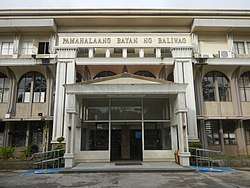
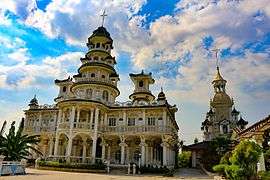


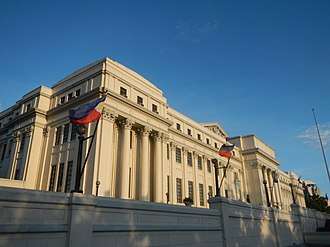
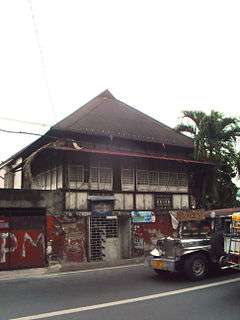
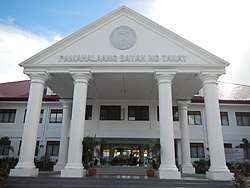
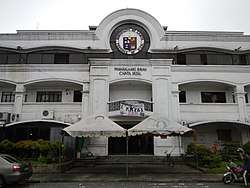
.jpg)
